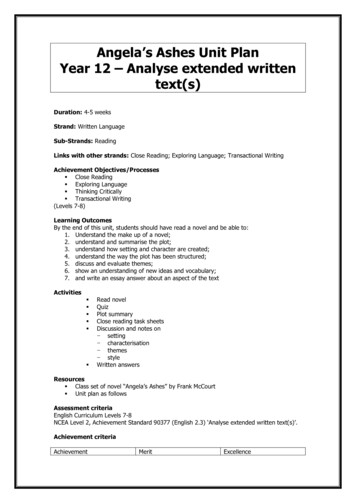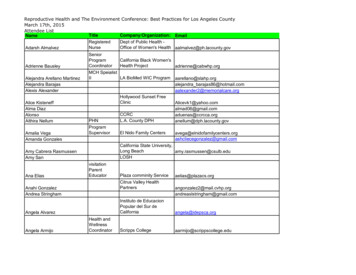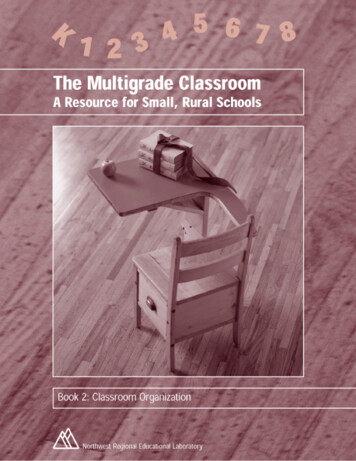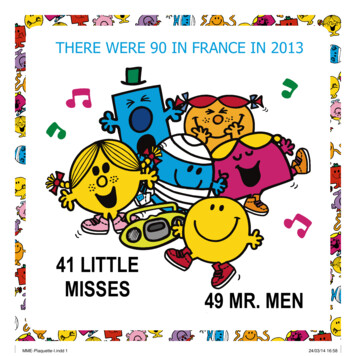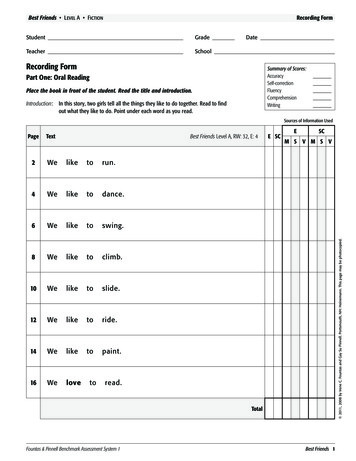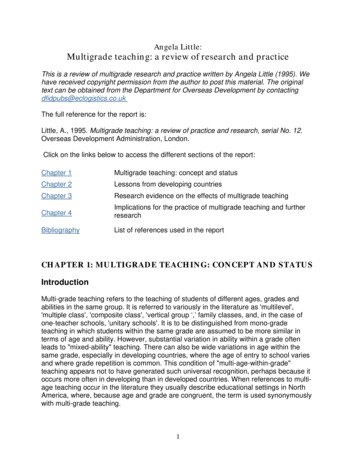
Transcription
Angela Little:Multigrade teaching: a review of research and practiceThis is a review of multigrade research and practice written by Angela Little (1995). Wehave received copyright permission from the author to post this material. The originaltext can be obtained from the Department for Overseas Development by contactingdfidpubs@eclogistics.co.ukThe full reference for the report is:Little, A., 1995. Multigrade teaching: a review of practice and research, serial No. 12.Overseas Development Administration, London.Click on the links below to access the different sections of the report:Chapter 1Multigrade teaching: concept and statusChapter 2Lessons from developing countriesChapter 3Research evidence on the effects of multigrade teachingChapter 4Implications for the practice of multigrade teaching and furtherresearchBibliographyList of references used in the reportCHAPTER 1: MULTIGRADE TEACHING: CONCEPT AND STATUSIntroductionMulti-grade teaching refers to the teaching of students of different ages, grades andabilities in the same group. It is referred to variously in the literature as 'multilevel','multiple class', 'composite class', 'vertical group ‘,’ family classes, and, in the case ofone-teacher schools, 'unitary schools'. It is to be distinguished from mono-gradeteaching in which students within the same grade are assumed to be more similar interms of age and ability. However, substantial variation in ability within a grade oftenleads to "mixed-ability" teaching. There can also be wide variations in age within thesame grade, especially in developing countries, where the age of entry to school variesand where grade repetition is common. This condition of "multi-age-within-grade"teaching appears not to have generated such universal recognition, perhaps because itoccurs more often in developing than in developed countries. When references to multiage teaching occur in the literature they usually describe educational settings in NorthAmerica, where, because age and grade are congruent, the term is used synonymouslywith multi-grade teaching.1
Several writers have pointed out that the first state-supported elementary schools inNorth America and Europe were un-graded. The school often consisted of one roomonly and one teacher taught basic literacy and numeracy to children from six to fifteenyears of age. In the US the "death knell of the one room school was sounded" after avisit by the Secretary of the Massachusetts Board of Education, Horace Mann, toPrussia in 1843. On his return he reported that the first element of superiority in aPrussian school. consists in the proper classification of scholars. In all places where thenumbers are sufficiently large to allow it, the children are divided according to ages andattainments, and a single teacher has the charge of only a single class. There is noobstacle whatever. to the introduction at once of this mode of dividing and classifyingscholars in all our large towns (Mann quoted in Pratt 1986)Urban education administrators in the US were soon to recommend that schools bedivided on the lines of age and grade, a development which was consistent with thedivision of labour in industry. The "principle of the division of labour holds good inschools, as in mechanical industry" (Bruck quoted in Pratt 1986). The model of monograde teaching, led by industrialisation and urbanisation, was to become a universalideal in the late nineteenth and twentieth centuries and came to dominate the basis ofschool, class and curriculum organisation used by central authorities.The persistence of the multi-grade reality towards the close of thetwentieth centuryYet despite the ideal, the multi-grade reality has characterised hundreds of thousands ofschools throughout the twentieth century and will continue to do so well into the twentyfirst. Although information about the extent of multi-grade teaching tends not to becollected on a regular basis, 1959 data were collected by UNESCO's InternationalBureau of Education (Table 1). Table 1 indicates the large number and proportion ofteachers who were teaching in one- teacher schools in the late 1950s - some 20-40% incountries of South and Central America, 16% in India, 25% in Turkey and 15% in theUSSR. The percentage of teachers teaching in one-teacher schools in some of theEuropean countries was also extremely high - 47% in Spain, 23% in Luxembourg, 20%in France, 10% in Switzerland. Figures in the US and UK were lower - 2.9% in the USA,3.6% in Scotland, 2.3% in Northern Ireland and 0.7% in England and Wales.Comparable data for the late 1980s/early 1990s are not available. Data on multi-gradedo not appear to be collected systematically by national and international agencies.Table 2 synthesises available information from a wide variety of sources on the currentstatus of multi-grade teaching. It expresses the incidence of multi-grade teaching at theprimary school level in different countries in the years for which the most recent data areavailable in a range of categories. In some countries the number and percentage of oneand two teacher schools is available. In others we have only been able to locate data onthe number and /or the percentage of schools which have multi-grade classes, or thenumber of classes within a system which are multi-grade. For one or two countries wehave established how many teachers there are per school or the percentage of teachers2
who teach multi-grade; and in one or two countries we have data on the percentage ofstudents who study in multi-grade classes.In India in 1986 over 300,000 schools were either one or two teacher schools. Theserepresented more than 60% of all schools. The percentage of schools which have onlyone teacher schools is 29%, suggesting a near doubling of the 1959 percentage (cfTable 1). In Sri Lanka the percentages are lower. However the seven hundred schoolswhich do have either one or two teachers are located in the most difficult environmentsin a country which has achieved near universal enrolment in primary school. In Malaysiatoo although the percentages appear small the multi-grade schools are located in thoseareas which are disadvantaged in several ways - Malay and Chinese schools in smallvillages and settlements and in the remote, secluded areas of Sabah; in the Tamilschools in rubber estates and the aboriginal schools in the interior and remote areas ofPeninsular Malaysia.In Peru the percentage of schools which are one-teacher schools is almost 40%. Theseschools are located in rural areas, predominantly in the Andean and Amazon regions ofthe country. In Zambia too the figure is high, at 26% in the mid 1980s. In Pakistan theaverage number of primary teachers per school was 2.3 in 1989 across the country, andonly 1.9 in rural areas where the primary cycle spans five years. Multi-grade classes arecommon in the primary schools of the Pacific Islands. They are also common in the ruralareas of industrialised countries. In the Northern territories of Australia for example 40%of schools have multi-grade classes. The comparable figure for France is 22% andsweden 35%. In Wales 30% of primary schools had between one and four teachers in aprimary cycle spanning seven years in 1976. In England more than 1,000 schools haveenrolments of less than 50 students.The gap between the multi-grade reality, teacher education andcurriculum assumptionsMulti-grade teaching is probably more common than we realise or care to admit. Table 1and columns 3 and 4 in Table 2 on one and two-teacher schools present only theextremes of the multi-grade reality. Any school with more grades (e.g. six grades ofprimary) than teachers (e.g. four teachers) must organise learning for some of itsteachers and students along multi-grade lines. And yet few Ministries of Education, fewCurriculum Development Agencies and few Teacher Education Institutions recognisethis reality. The knowledge required to work effectively within it appears not to betransmitted via textbooks on curriculum and teaching methods, via syllabi, via teacher'sguides, nor via the content and pedagogy of teacher training colleges or Universities.The knowledge required for effective multi-grade teaching is rendered illegitimate bythose with a responsibility for training and supporting teachers in their work.A brief review of standard texts on curriculum development illustrates the point. Theselection was made from the library of the Institute of Education at the University ofLondon, which houses one of the largest English language collections of texts oneducation. The literature which addresses primary schools tends to assume that same-3
age class groups are the basic organisational units for which curricula are developed.There is no mention of multi-grade, multiclass or mixed-age teaching in a collection onAims, Influence and Change in the Primary School Curriculum, edited by P.H.Taylor andpublished by the UK's National Foundation of Educational Research in 1975. Morerecently, Blenkin and Kelly (1987) write on The Primary Curriculum: a process approachto curriculum planning. Again there is no mention of multi-grade. A mono-grade structureappears to be the taken-for-granted form of organisation. An American textbook byShepherd and Ragan (1982) refers to the "non-graded schools movement" in the USwhich had challenged nineteenth century American policy assumptions about the idealorganisation of learning and had encouraged de facto a multi-grade approach. Howeverthe impact of this movement in the US was shortlived and it is perhaps for this reasonthat Shepherd and Ragan make no reference to multi-grade teaching groups in theirchapter on "curriculum delivery". In Understanding the Primary Curriculum, Boyd (1984),writing from an English perspective, makes no mention of multi-grade teaching but whendiscussing school-based curriculum development does mention the value of a flexibleapproach to the grouping of children. The problems of coping with special educationalneeds, ethnic differences, gender and new technology are addressed in the section on"curriculum issues" but the issues faced in multi-grade, multi-class and small schools donot warrant a mention. In view of the small proportion of schools in both the UK and theUS in which multi-grade teaching occurs one can perhaps understand its exclusion fromoverviews of primary education organisation and curriculum, notwithstanding the factthat the issues are central to the needs of multi-grade teachers. However, it should benoted here that our review has barely scratched the surface of a Scandinavian literatureon multi-grade teaching. Reports on the extent of multi-grade teaching in primaryschools in Sweden by Malmros and Sahlin (1992) and in Finnish secondary schools byLaukkanen and Selventoinen (1978) suggests that multi-grade teaching enjoys apositive reception by many teachers, is adopted for pedagogical reasons and is seen asa fertile ground for the development of new curriculum ideas for all types of school, notsimply multi-grade.The exclusion of the discussion of multi-grade teaching, and the implicit assumption thatmost teaching occurs within a mono-grade organisation is the more surprising in textswhich purport to focus on the conditions of schooling in developing countries. In 1986the National Institute of Educational Research in Tokyo undertook a study of theelementary and primary school curriculum in the countries of Asia and the Pacific (NIER1986). Although the information presented on class size indicates that multi-gradeteaching is rather widespread none of the country reports makes specific mention of it.The text on India, Australia and Nepal includes sections on school organisation,methods of teaching and classroom management. None addresses the implications forthese of the multi-grade reality. In other words it appears to be a "non-problem".Although the report on Pakistan mentions that one of the problems is a lack of trainedteachers to handle multiple classes, this issue is not re-addressed in the account ofteacher training. In his Curriculum and Reality in African Primary Schools, Hawes (1979)makes a passing reference to single teacher schools in his discussion of officialeducation statistics. Class sizes in "deep rural" areas are often low and uneven, and4
it is common to find small classes sharing a classroom, sometimes with a single teacher,sometimes with more than one but nearly always seated as a separate group with theirown 'territory' and blackboard, for their exists a strange orthodoxy that a teacher withmodest education and training 'cannot be taught to handle more than one class at atime'. (Hawes 1979:15)Unfortunately Hawes neither explores the orthodoxy nor challenges it. Elsewhere heexplores the problems of large class teaching, but not in relation to mixed-grade/ageclasses (Hawes 1978). The omission continues in Onwuka's (1981) edited collection onCurriculum Development in Africa and Grant's (1978) discussion of School Methods withYounger Children written for an African audience.In general then it would appear that a mono-grade organisation of schools remains thetaken-for-granted assumption of most of those who research and advise on curriculumdevelopment in both developed and developing countries. Multi-grade teaching isassumed either not to exist, or to do so but in such small measure that it defiesattention, or to exist at the margins but to be non- problematic, or to be recognised asproblematic but non-solvable - and therefore best not mentioned!There are a few exceptions to this dominant educational literature. Although UNESCOdoes not collect routine statistics on the extent of multi-grade teaching within schoolsystems globally, it has, since 1961, recognised that it is an educational condition inneed of constant support and attention. The one-teacher school conference sponsoredby the International Bureau of Education in 1961 and the International conference ofMinistries of Education led to the establishment of unitary schools in Latin America(UNESCO 1961). Throughout the 1980s the Asia and the Pacific Programme ofEducational Innovation for Development (APEID/UNESCO) discussed the continuingproblems faced by multi-grade teachers (e.g. UNESCO 1981,1982,1988,1989),especially in rural, isolated and sparsely populated areas. Their 1989 report confirmedmany of the curriculum points raised above about the marginal, peripheral andanomalous status of multi-grade teaching and schools. The summary of experiencesfrom Australia, Bangladesh, Peoples Republic of China, India, Indonesia, Republic ofKorea, Malaysia, Maldives, Nepal, Pakistan, Philippines and Thailand confirmed that: primary curriculum documents and their associated lists of "minimum learningcompetencies" have not been specifically designed for use by teachers in multigrade schoolsschool plans, instructional materials and methodological guidelines are oftendifficult to apply to multi-grade teaching situationsthere is a shortage of support materials for teachers and individualisedinstructional materials for learnersthere is a need for more work on the kinds of continuous evaluation, diagnostictesting, remediation and feedback which would best assist multi-grade teachingand added that5
although many teachers work in multi-grade teaching situations few countrieshave developed special teacher training curricula for pre- or in-service training.Teaching practice during preservice is invariably carried out in mono-gradeschoolsteachers posted to teach in multi-grade schools "develop a sort of psychologicalalienation from the school"the educational system as a whole pays inadequate attention to the properfunctioning of multi-grade schools through, for example, not filling vacant teachingpositions in rural areas, the absence of systems of teacher accountability, a lackof basic physical facilities in these schools, lack of training for supervisors ofmulti-grade schools and a general "inattentiveness of education officers to theneeds of these schools"adapted from APEID (1989)The purpose of this review is to draw together material from a range of multi-gradeeducational settings. The difficulties which we have faced in identifying and locatingmaterial and in having a modest amount of it translated reflects its status on the fringe ofnational systems of education, of national and international research and policy agendaand of information networks. It is an educational condition barely addressed in nationalpolicies of education, almost non-existent in the content of teacher education courses,ignored by national curriculum developers and located in the research journals whichdeal with matters rural or peripheral to the mainstream of educational debate. It isessentially a problem faced by teachers and students in peripheral rural areasunsupported and unrecognised by mainstream and centralised education systems. Weare confident that our review has scratched only the surface of the total stock of writtenmaterial and collective professional advice but recognise also that much of it hasprobably been written by teachers working in peripheral settings and that it remains atthe periphery of networks of information dissemination.CHAPTER 2: LESSONS FROM DEVELOPING COUNTRIESIntroductionFive innovations in multi-grade teaching over the past two decades in developingcountries are presented in this chapter. The first two experiences, from Zambia andColombia, have addressed the multi-grade reality of rural primary schools directly. TheZambian experience is less than ten years old and relatively small-scale. The Colombianexperience spans three decades and is large-scale. Both have involved externalagencies and support from the government mainstream. The third experience, fromPeru, describes the multi-grade reality found especially among indigenous communitiesand the recent involvement of NGOs in teacher education programmes oriented towardsmulti-grade teaching. The fourth, from Sri Lanka illustrates how some solutions to theproblems faced by the multi-grade teacher are being offered on a small scale through6
the recognition that even mono-grade classes contain very wide differences inachievement and that a single grade may be conceived as a multi-grade context. Thefinal experience draws on innovations in rural primary education in several countries.Project Impact began as a radical reform of primary education in Indonesia and thePhilippines and expanded subsequently to Liberia, Malaysia, Bangladesh and Jamaica.Although not oriented exclusively to the problems of multi-grade classes, many of thefeatures of the innovation offered solutions to them.1.0 Zambia: teacher education and support for multi-grade schoolsThe 1984 education census returns in Zambia indicated that 800 of the 3008 primaryschools were "ungraded" (i.e.26%), meaning that although the full cycle of primaryeducation consisted of seven grades these schools offered only four. These ungradedschools had fewer teachers than grades, small enrolments in each grade and werelocated in remote and sparsely populated areas.Much of rural Zambia is sparsely populated. In 1990 the population density was 11persons/sq.km In 1980 this figure was even lower - 7.5 persons/sq.km. 1990 figures forIndia and China, by contrast, are 260 and 118 respectively. Although the populationgrowth rate of 4% between 1980 and 1990 is among the highest in Africa the rate insome areas is low and declining, with implications for the pattern of provision ofeducation and other social services.While a majority of children attending primary school in urban areas completes sevenyears of primary education, the percentages are smaller in rural areas where enrolmentin an ungraded or incomplete school represents a terminal educational experience. Aparticular problem faced in many of these incomplete schools is the small enrolment ofchildren in each grade. The problem is essentially one of resources - rural communitiesin sparsely populated areas too impoverished to contribute to the physical developmentof a school, and the high costs of providing teachers to teach each grade separately.Two solutions have been adopted (Lungwangwa 1989). The first, tried out in 50 of the800 schools, is a biennial intake in which students enrol in grade 1 only every secondyear. The second is the use of multi-grade teaching in which two or more grades aretaught simultaneously.Multi-grade teaching was introduced to a number of Zambian primary schools in ruralareas in the mid 1980s as part of a consciously formulated "project" supported by theMinistry of General Education and Culture and the Swedish International DevelopmentAuthority. It started from a very small base in four schools in Mkushi district and wasextended to a further 40 schools in 1986 and 50 in 1987. It was argued that multi-gradeteaching would enable small schools with low enrolments in each grade to upgradethemselves to complete grade 7 primary schools without requiring additional classroomsand teachers.In-service training courses in multi-grade teaching were developed and mounted by theMalcolm Moffat Teachers' Training College (MMTTC). Others "inputs" to the project7
consisted of language and maths texts and exercise books, follow-up seminars,inspection, evaluation and the incorporation of multi-grade teaching as part of theregular preservice teacher training programme.Three alternative approaches to curriculum organisation and teaching appear to havebeen promoted by the MMTTC.the common timetable option : where all children learn the same subject in a giventimetable period, but each grade group follows its own work, according to its own workprogramme and grade levelthe subject stagger option: subjects are staggered on the timetable so that gradegroups learn different subjects in the same period. Subjects which require high teacherpupil contact are matched with those requiring littlethe subject grouping option: subjects are presented to all grade groups together at thesame time. Some subjects eg music, art, religious knowledge and social studies lendthemselves well to this option.An evaluation of the four pilot schools and the College's involvement in teacher's trainingwas undertaken by Lungwangwa (1989). The evaluation addressed :the extent to which the multi-grade system had enabled all children in a school catchment areahave access to the full primary level programmethe costs of this form of provisionthe role of the teacher and the nature of his pedagogical activities in a multi-grade schoolthe impact of multi-grade teaching on the cognitive achievement of studentsthe impact of this form of teaching in promoting independent and self-directed habits of studythe internal efficiency of multi-grade schoolsthe impact of multi-grade teaching on the participation and performance of girlsthe perceptions of multi-grade teaching held by participants, parents of students ad the widerlocal communitythe impact that the introduction of this system has had on the attitudes and mores of the localcommunity (Lungwangwa 1989:13-14)The CollegeThe Malcolm Moffat Teacher Training College (MMTTC) is the Zambian-designatedinstitution for the formal in- and pre-service training of multi-grade teachers. Keensupport was lent to the idea of multi-grade teaching by the principal, the vice-principaland the multi-grade "coordinator", the first two persons having had some prior exposureto it in Australia in the 1970s. Despite the obvious enthusiasm of these key individuals anumber of problems have been encountered in the implementation of the trainingprogrammes. Lungwangwa's (1989) review notes that(i) By 1988 the multi-grade teacher education course had not been well integrated intothe mainstream programme for teacher preparation. Since most members of staff had8
themselves no experience of multi-grade there was anxiety and a general lack ofenthusiasm for it.(ii) multi-grade training has enjoyed the status only of an extra-curricula activity since itsinception and has been timetabled to occur during the "last few days before teachingpractice commences"(iii) Because of its lack of formal status students do not take it seriously (and ).see it asa filler not as an important component of their training. there are no examinations inmulti-grade teaching .(and it). is resented because it is considered to be a preparationto teach in the remotest parts of the country, a situation they would like to avoid at anycost(iv) The four lecturers involved in the multi-grade programme feel "overstretched"because their teaching loads are already full. They feel that the absence of specialremunerations and formal training in multi-grade affects their recognition and status(v) A scarcity of resources in the schools restricts what the trainees can do during theirmulti-grade teaching practice. "Independent learning" is seen by staff to form the basisof multi-grade teaching and this, in turn, rests of the availability of learning resources.Despite these perceived constraints, however, college staff believes that multi-gradeteaching can have some positive outcomes. It can enhance independent learning, itencourages teachers to adopt pupil-centred approaches to teaching, it facilitatesrevision of materials covered in earlier grades, it increases pupil interaction andcontributes to the country's objective of universalising basic education.The SchoolsThe four pilot schools were visited and evaluated in line with the points noted above. Wepresent here just two of the four cases, contrasting in several respects.The Mwape primary schoolMwape Primary School was established by Jesuit missionaries in 1945. Between 1945and 1963 children who completed the grade 4 and who wished to continue their primaryeducation enrolled in grade 5 at the Chingombe mission boarding school, some 75 km.away. Few students continued because of the distance and the annual boarding fees. In1964 the Mbosha school was established at a closer location and it was estimated thatabout 5 children proceeded to grade 5 each year between 1964 and 1984. However fewof these remained beyond the end of grade 5 because of the boarding costs, andbetween 1970 and 1984 only three students who began their education at Mwapesucceeded in graduating from grade 12.The introduction of multi-grade teaching has resulted in increased enrolments althoughmigration out of the area and the greater attractiveness of another primary school9
(where children receive free uniforms) has led to increases smaller than might havebeen expected. By 1988 45 boys and 43 girls were enrolled, compared with 17 boys and16 girls in 1983. In 1988 the school served 10 villages.There are two teachers. One teaches grades 1 and 2 in the morning and 3 and 4 in theafternoon. The other teaches grades 5, 6 and 7 as a combined class. The teachersexpressed concern over lack of resources and workload. Requests from them for a thirdteacher had gone unheeded. Because formal lessons were taught during both themorning and afternoon, creative work, practical skills and production unit activity hasbeen displaced. Despite these constraints the teachers were pleased to report that ofeight students who sat the grade 7 examination in 1987 four had qualified for grade 8.The school-community relationship was not particularly strong and no contribution hadbeen made by the parents towards the rehabilitation of school buildingsKalombe Primary SchoolThe Kalombe school experience has been a little different. The school, which currentlyserves four villages, was established later than Mwape, in 1965, and between then and1984 those children who proceeded to grade 5 attended a school 19 km away. Theweekly boarding fees prevented most children from proceeding and the Kalombe schoolwas regarded as a "dead end" by most parents. After the introduction of multi-gradeteaching, enrolment increased rapidly, from 123 in 1985 to 204 in 1988. However thenumbers in each grade are now large enough to justify a mono-grade structure wereadequate numbers of teachers available. One of the reasons for the increasedenrolment has been in-migration, due mainly to a resettlement scheme. Parentsexpressed the view that the provision of upper primary grade schooling, made possiblethrough the multi-grade teaching, had been one of the attractions of settling in the area.There are three teachers in the school, two of whom were trained teachers and hadspecialised in multi-grade teaching. However they recalled that their multi-grade trainingconsisted of two weeks practice in 1984 which, though valuable, was inadequate. Theyfelt a need for more in-service training in multi-grade teaching and felt that the conceptof multi-grade teaching should be introduced to all teachers as part of the normal preservice training. The system of multi-grade teaching had been implemented "vigorously"and the recommended methods had been tried out. Teachers felt that the 'commontimetable' and 'subject stagger' approaches had been the most useful, partly because ofthe large numbers of students involved. Unfortunately the volume of learning resourceshad not kept pace with increased enrolments, making the idea of "independent" learningdifficult to implement. Increased enrolments were also creating pressure on desk andseat space. In general the teachers felt that the present enrolment justified their schoolbeing upgraded to a mono-grade 'complete' primary school. Its continued classificationas a multi-grade institution, they felt, led to too great a workload for the teachers.Teachers felt that with multi-grade teaching students were better prepared for selflearning after they had left school. It was felt that multi-grade teaching contributed10
greatly to the mastery and enduring impact of basic skills, an interesting perceptionwhich could warrant further investigation. The progression rate from grade 7 to 8 , of12.5% in 1987 was of a level similar to the national average.In contrast to Mwape th
text can be obtained from the Department for Overseas Development by contacting dfidpubs@eclogistics.co.uk The full reference for the report is: Little, A., 1995. Multigrade teaching: a review of practice and research, serial No. 12. Overseas Development Administration, London. Click on the links below to access the different sections of the .
